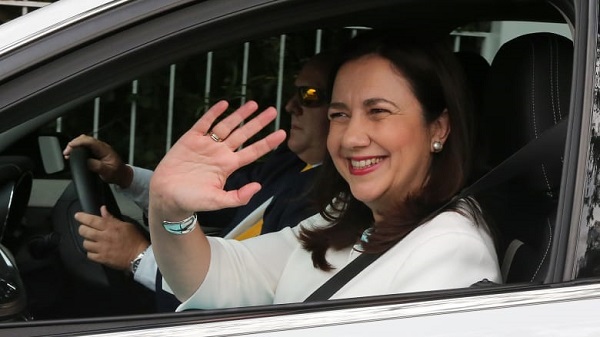Adrian Beaumont at The Conversation has a good summary of the election:
- At the Queensland election, held on November 25, the size of parliament was increased from 89 seats to 93. Comparing this result with 2015, Labor officially won 48 of the 93 seats (up four), the Liberal National Party 39 (down three), Katter’s Australian Party (KAP) three (up one), and One Nation, the Greens and an independent won one seat each.
With 45 seats held by parties other than Labor, Labor has won a three-seat majority.
Adjusted for the new boundaries and excluding defections, the 2015 results gave Labor 48 seats and the LNP 43. Using this interpretation, there was no net change for Labor, while the LNP lost four seats.
Labor gains from the LNP in Gaven, Aspley and Redlands were countered by losses in Bundaberg, Burdekin and Mirani (to One Nation). The LNP also lost Maiwar (to the Greens), Hinchinbrook (to KAP) and Noosa (to an independent). This is the first Greens elected MP in Queensland.
Townsville was expected to be very close, but Labor won it by 214 votes (50.4-49.6), clinching its 48th seat.

Here is Palaszczuk on her way to the gov, Paul de Jersey (I went to university with him):

Final primary votes were:
- 35.4% Labor (down 2.1 since 2015), 33.7% LNP (down 7.6), 13.7% One Nation (up 12.8), 10.0% Greens (up 1.6), and 2.3% KAP. This is the Greens’ highest primary vote in a Queensland election.
Here he is, Michael Berkman, the first Green elected to parliament in Queensland:

The Greens vote was undoubtedly boosted by the Adani issue. It will be interesting to see whether this vote is sustained as Adani tanks and Labor’s renewable energy program becomes more obvious.
Of course by then the whole coal mining industry may be on the nose.
On the news we heard that the LNP has only two seats north of Bundaberg. So LNP is mostly the Gold Coast, the Sunshine Coast, Toowoomba west and a slab of country inland from the Sunshine Coast to Bundaberg.
This is Joh country. Deb Frecklington, deputy to Tim Nicholls, holds the seat of Nanango, with her electoral office in Kingaroy.
Her main opposition is John-Paul Langbroek from Surfers Paradise, although Mark Robertson from Oodgeroo, one of a handful of LNP members left in Greater Brisbane, has thrown his hat into the ring.
Campbell Newman has attacked Frecklington. Tim Nicholls says he takes full responsibility for the the failed LNP campaign. But Frecklington was at his shoulder throughout the campaign. Newman:
- demanded Ms Frecklington also take responsibility for the “appalling” election loss and described her nomination as “implausible”.
“Deb Frecklington, as a part of a leadership team that led the LNP to a 34 per cent primary vote, needs to take accountability for that loss and should not be running as a leadership contender,” he said.
Annastacia Palaszczuk says if the LNP don’t get behind Frecklington the Nationals will break away.
John-Paul Langbroek says only his leadership can restore the public’s trust in the LNP after an ‘appalling’ performance at the election.
Langbroek has been leader before. When he was, I recall the country Nationals did not much like him, so Palaszczuk might be right. One of his problems was mumbling and hesitance when facing the media.
Former Treasurer Curtis Pitt has been shunted upstairs to Speaker, ironically it is said because he fluffed his lined too often as treasurer. He will be replaced by Jackie Trad.
- Ms Palaszczuk will take over the Trade portfolio, and has confirmed her Cabinet will be expanded by one to make room for Member for Barron River [Cairns North] Craig Crawford.
Here’s the new economics team, which includes Cameron Dick and our local member Kate Jones:

At least two of them, Trad and Jones, were against Adani.
Crawford replaces Pitt as a representative of the Far North. I believe the team is perfectly balanced in terms of gender.
Grace Grace takes over schools from Jones, Stephen Miles moves from the environment to health to replace Dick (not sure he wanted that) and is replaced by Leeanne Enoch, the Indigenous woman who formerly had innovation.
Innovation, which centres around the Advance Queensland initiative which is more than startups and was backed by $405 million in funding from June 2016, now becomes a core economic portfolio.
Media statements have started to flow again, so here’s Palaszczuk:
-
Premier Annastacia Palaszczuk will lead a four-member economic team of senior Ministers in State Cabinet to drive job growth across Queensland.
- Deputy Premier Jackie Trad will be appointed Treasurer and Minister for Aboriginal and Torres Strait Islander Partnerships
- Cameron Dick will be appointed Minister for State Development, Infrastructure and Planning and Minister for Manufacturing, with responsibility for Economic Development Queensland and Queensland Reconstruction Authority.
- Kate Jones will be appointed Minister for Innovation, Minister for Tourism Industry Development and Minister for the Commonwealth Games. Minister Jones will also have responsibility for International Education.
The Premier will add Trade to her own responsibilities and she will chair the Cabinet Budget Review Committee, with senior Ministers to hold key economic roles.
“Almost one in three new jobs created in Australia this year have been created in Queensland. Indeed, working with business and industry, we have created more than 130,000 jobs in our first term in office – an average of 130 new jobs every day,” she said.
Trawling through the Advance Queensland media statements I found one on Brisbane Airport becoming a biofuels hub.
- The Palaszczuk Government has already signed a biofuel agreement with the US Navy as part of its Great Green Fleet initiative, which is a commitment by the US to source 50% of its fuel needs from renewable sources by 2020.
They are looking at a $1 billion biofutures sector by 2026.
Somewhere I recall a reference to 1680 new startups in Queensland since April 2016, creating 4800 jobs, making Queensland second only to NSW for startups.
Twice on radio I’ve heard Chief Entrepreneur Steve Baxter say with excitement that businesses every country town will be connected to the electricity grid will be able to be connected to a fibre network installed for administrative purposes but with heaps of spare capacity giving speeds equivalent to those available in Brisbane CBD. He reckons it is up there with bitumen roads as a piece of new infrastructure. Can’t find a link.
I suspect that when this becomes well known it might change some negative attitudes towards innovation in the regions.
Labor has been putting effort into Skilling Queenslanders for Work and TAFE colleges which the LNP had gone a fair way in selling off the real estate, leaving it to the private market.
What we need is to develop a vibrant Mittelstand of innovative firms. We have a real prospect of achieving that now.
In three years time, if the economy improves and if One Nation is still around I think the LNP may find it hard going. In today’s CM there is an article saying that government receipts from coal exports will be up by a billion to $1.8 billion. Another article says there is already $3 billion worth of new renewable energy projects to start in 2018.
It will be interesting to see whether the Greens make headway. Michael Berkman is an environmental lawyer, who worked for the Environmental Defenders Office (Qld) Inc. He comes across as sensible and competent, with a simple philosophy of putting people before profit.
He has an interesting policy on electricity and power bills. Much of what he proposes simply won’t happen, but I do agree that we should do away with private retailers. If Alinta can offer a 25% discount, then everyone could have it simply by replacing private enterprise ticket stampers with a government retailer.
Meanwhile Pauline Hanson supports Tim Mander, Frecklinton’s running mate, who should go well in the bush because he wants farmers to have more guns.
That is not the way to win seats for the LNP in Brisbane. Let alone the fact that nearly all the remaining LNP members are likely to be outright deniers of human-caused climate change.
Update: Here’s the list of ministers and assistant ministers, I gather in order of seniority.


Here’s the list of ministers and assistant ministers, I gather in order of seniority.
FWIW, I spent 90 minutes with Craig Crawford prior to the election. I found him very personable and a ready listener.
In real life Craig was a qualified paramedic, one of those highly trained first responders who gives you the best shot at living before hospital.
Given his role as Emergency Services Minister he comes with a reasonable background for the position, maybe better than some of the other appointees.
Hi Brian
For non-Queenslanders, would you mind assigning names to the stunningly handsome four pictured above?
Ta
Sorry Ambi, privacy laws….
Oh dash it!
Was that photo a selfie they sent to Brian??
Has he breached privacy by publishing it here? Is that what they mean, these folk who talk about Revenge Prawn?
Heavens to betsy, I just cannot keep up.
Ambi, they are in order Jackie Trad, Annastacia Palaszczuk, Cameron Dick and the lovely Kate Jones, who is our local member.
Trad and Jones are said to be from the ‘left’ and opposed Adani to anyone who asked. Dick is from the ‘right’ and would have favoured Adani.
Geoff, there has been some criticism emanating from the north after Curtis Pitt was dispatched to Speaker. Fair enough, but I do think they will go out of their way to keep the north happy.
The CFMEU came out and roasted the lineup, saying some are too stupid and lazy to do much good. So much for union domination!
Some I don’t know, but I think there is quality in the front bench and I’m a tad excited. Mark Bailey has lost electricity to Dr Anthony Lynham. Don’t know about that, but the renewables program has so much momentum I think it will be alright. They must have good people working on it.
Opposition leaders will be Deb Frecklington and Tim Mander, a very conservative duo.
Frecklington is said to have law and business, but was a protege of Jeff Seeney, one of the most despised even by his own side, and a major driver of the Newman putsch.
Brian,
I wonder whether it will happen that quickly. On Monday morning, Tony Abbott MP was having a final chat for the year with Ray Hadley on Radio 2GB. Here’s some of what he said:
In Abbott’s comments, I see some logical fallacies and factual errors:
• Who has said batteries and pumped-hydro “is going to solve all our problems”? These are energy storage systems that require primary energy generation to function, so they clearly cannot “solve all our problems”. Energy storage systems can be beneficial/complementary to the efficient operation of coal-fired generators. Abbott is employing a straw man argument here;
• If coal and natural gas are “the only way we can have reliable base-load power”, what happens when non-renewable coal & gas inevitably become scarce and unaffordable? Coal-fired generation is not ‘dispatchable’ (i.e. vary energy output promptly/rapidly), and can only be operationally effective/efficient in conjunction with ‘dispatchable’ generation (e.g. gas-fired, primary hydropower, pumped-hydro energy storage, battery storage, and solar thermal with energy storage, etc.). It’s in society’s best interests to ensure renewable energy solutions are viable, reliable electricity generation alternatives and deployed BEFORE coal and gas supplies become scarce and unaffordable;
• The current Australian domestic gas supply problem was initiated by the federal Howard government when it approved far too many LNG trains, without any regard to having a sufficient ongoing domestic supply, and aided and abetted by the Rudd/Gillard/Rudd and Abbott/Turnbull federal governments and various successions of state governments. Australia could exhaust nearly all its natural gas Economic Demonstrated Resources (EDR) by 2035, according to Figure 9.2 in the Energy White Paper 2012. Per BP Statistical Review of World Energy 2017, USA produced just over one-fifth share of the world’s total natural gas production in 2016, yet only had a proved reserves-to-production at the end of 2016, of 11.6 years. Why invest in new gas-fired generation when all of Australia’s ‘easy gas’ supplies could all be gone in about 2-3 decades, and global gas supplies are likely to begin a sustained declined around 2020?
• Liddell Power Station is likely to close in March 2022. That’s in a little over 4¼ years – not 5 years. New ultra-supercritical coal-fired power stations are likely to take 6-9 years to build – not 5 years, and even if it could be built in 5 years, it’s still too late to replace Liddell. The feasibility study for “Snowy 2.0” has still not been completed, and it’s getting too late now for it to replace Liddell before it closes. It’s still not too late for gas-fired generation to replace Liddell, but gas supplies will likely continue to get more expensive – we need to rapidly reduce our gas dependency. Concentrated solar thermal with energy storage is the only primary energy, long-term, affordable, zero-carbon emissions, ‘dispatchable’ option remaining that could be operational within 4 years. But if we dither much more we will run out of ALL options to avoid steeply rising power prices and unreliable electricity supply.
I don’t think Tony Abbott is the only politician thinking this way (and blaming others for his own culpability for the current energy security predicament). And I think there’s still a considerable number of Australians, who are ill-informed, who would still agree with him. The media doesn’t help, by failing to report accurate data and competent analysis, and allowing people like Tony Abbott a free ride, unchallenged on his comments.
And the coal lobby is hugely powerful and well-resourced. I think they know the writing is on the wall, but like the tobacco industry, it’s all about delaying the decline for as long as they possibly can. I think they take advantage of people’s lack of knowledge on this subject, and employ misinformation and instil fear, which assists with maintaining their continued survival for longer.
It will be much more difficult for the coal lobby/Tony Abbott to prosecute these fallacious arguments once the SA battery system and the Aurora project demonstrate operational successes – but this will take time, and we don’t have any more time left for inaction on both climate change and energy security.
(For the record: Brian, I trust you already know the issues, but others that have discovered and are observing this website recently may not be aware)
Geoff M I have to go out to work, but briefly, the notion of ‘baseload’ is yesterday’s thinking. Abbott is a fossil from a bygone era.
I’ve got a new post up on pumped hydro in old mines, and plan to do one tonight on the AGL Liddell response.
Geoff M
Just briefly, this dispatchable power term has been introduced to muddy the waters, I think.
As John D, Brian and others here have pointed out, and as you say, coal powered generators need hours to fire up. They can run for many hours once hot, but cannot be turned on rapidly.
Mr Abbott refers to pumped hydro merely to take a swing at
Snowy Mountains 2.0Malcolm Turnbull, I reckon.Ambigulous (Re: DECEMBER 13, 2017 AT 5:00 PM):
‘Dispachability’ is important. If you want zero-carbon emission electrical energy, but the wind isn’t blowing or the sun is not shining and there’s inadequate primary hydro-power, then unless you have energy stored somewhere, then you have a blackout.
The danger with “Snowy 2.0”, or any discrete energy storage, is it enables coal-fired power to continue producing emissions for longer – a lifeline for coal. See this post here, which includes this statement under the sub-heading Australia’s Problem Is Coal — Not A Lack Of Energy Storage:
We need more renewable primary energy generation, which can be managed. That’s why I tend to favour CST with energy storage because: it’s manageable output to the grid (NEM), it has zero-carbon emissions during operation; it’s renewable primary energy generation; it’s ‘dispatchable’ with the integrated energy storage feature; it can be built within four years; it can continue to produce energy for 50+ years; it uses relatively abundant, non-toxic materials in construction that can be readily recycled when decommissioned; and is now becoming cheaper than new gas-fired generation and competitive with new coal-fired generation.
Energy storage can enable coal to prevail longer and emit more carbon emissions and other “pollutants”. CST displaces new gas- and coal-fired generation. Isn’t the primary goal to reduce GHG emissions to zero by 2050?
Geoff M you make some good points. But I see CST as relatively fragile compared to pumped hydro. It’s a security thing. If you rely on CST then the plants them selves become immediate targets in a conflict scenario. Demolition is easy but re-building is not, and may take years if at all possible. Pumped hydro is vulnerable too but much more amenable to repair in a timely fashion than CST.
Sorry if I am sounding too farfetched but if you keep an eye on world events you would have to consider that risk exists and is increasing. Security of power assets has become more important.
Ambi, the term “dispatchable” has muddied the waters for some, but as I explain in an earlier post, the electricity market is being reshaped. What we need now and in the future is better described as dispatchable, rather than baseload.
Yes Brian.
Geoff M, I wasn’t arguing against storage, nor was I arguing against solar or wind generation.
I was attempting to indicate that the “dispatchable power” rhetoric had been used to argue against transforming our power sources to renewable, low carbon methods.
You seem to be saying “large scale storage of electric power now will only excuse and camouflage continued generation using fossil fuels”.
I disagree. Lots of folk in Victoria are keen to adopt or extend their own domestic rooftop solar PV, because, and principally because domestic battery storage seems to them just about affordable now, and they are very keen to guarantee lower carbon power by organising/installing it themselves.
Are you with that famous Saint, who prayed “Let me be pure, oh Lord, but not yet!!”
Folk aren’t waiting for you to give them the green light (on storage) Geoff M. They are making their own decisions, now.
Best not to get in their way, eh?
There was a stray word in the last sentence of my last comment. Now it reads:
Geoff Henderson (Re: DECEMBER 14, 2017 AT 11:23 AM):
I think you are being far-fetched. I think your argument is rather flimsy. There are many ways of disrupting the grid, that I’m not going to discuss here publicly.
CST+storage is a primary energy generator. Pumped-hydro energy storage (PHES) is not. PHES requires energy from somewhere else to provide the means to pump water to the top reservoir before it can deliver energy – this is a vulnerable position. PHES consumes more energy than it can reproduce – another negative. PHES can allow coal to linger longer because PHES is complimentary for coal – another negative. I’m not saying PHES should be ruled out as an option, but there are some deficiencies that need to be considered and the consequences carefully weighed, that I think you are glossing over.
Ambigulous (Re: DECEMBER 14, 2017 AT 9:55 PM):
It can – that’s what we need to watch out for. My point is we need more renewable primary energy generation, to lower carbon emissions to net zero by 2050. PHES can delay that from happening.
OK Geoff M.
Those are points many Australians will agree with.
John D has brought this one from Tim Colebatch to my notice:
The election was essentially decided on first preferences, and One Nation voters largely ignores party preferencing.
GM: Any form of energy storage can complement any form of power generation under some circumstances. The business case will depend on issues such as when the power source can produce surplus power for storage, storage efficiency, how difficult it is for the generator to change output and the marginal cost of producing surplus power.
The case also depends on the cost of backup power and the cost of reducing peak demand by temporally limiting power going to some customers.
One of the attractions of solar thermal with molten salt energy storage is the back-up can come in the form of low capital cost back-up molten salt heating.
Geoff M:
Geoff M over the past few years I’ve argued that we need to get to net zero by 2030, and then go negative to reach 350ppm by 2050.
Now I’m inclined to think that might be a bit too slow.
Brian (Re: DECEMBER 19, 2017 AT 10:00 PM):
The “Paris Climate Agreement”, that most countries have signed, are subscribing to that goal.
The evidence points more and more to your conclusion. Yet there is little action to achieve either.